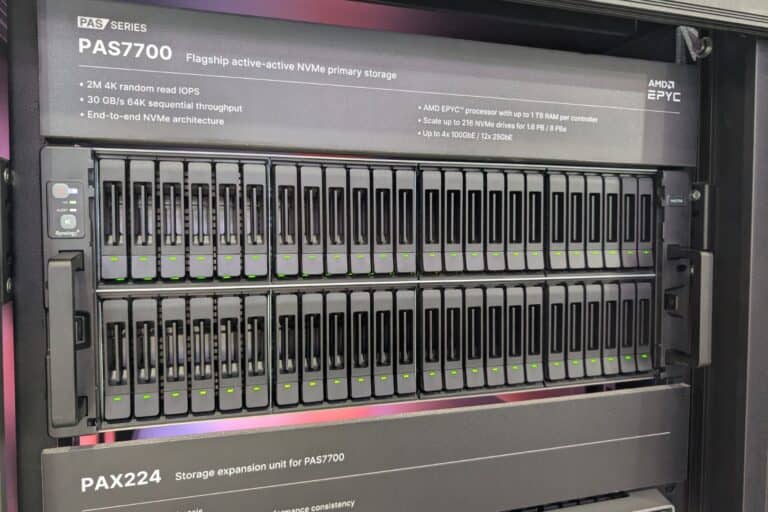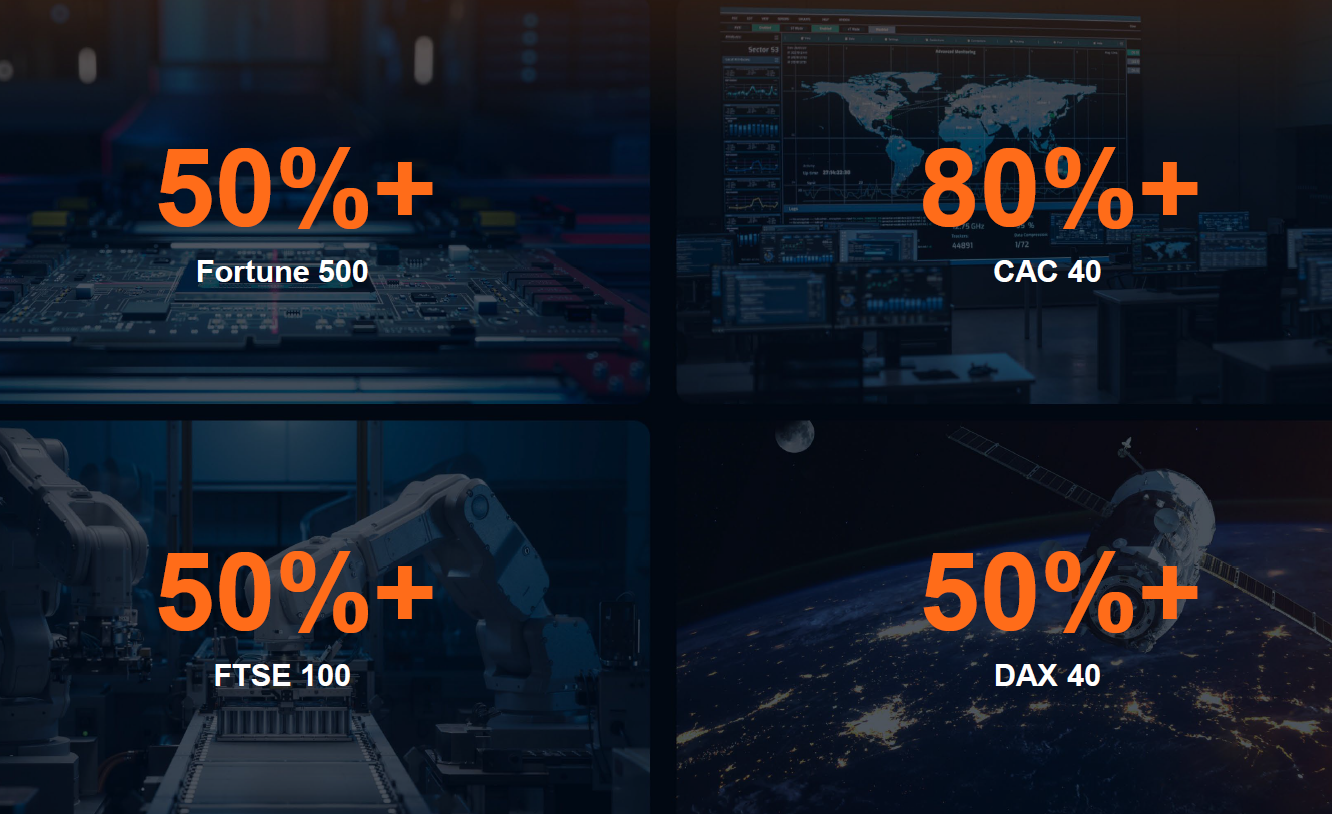During a special event at Computex 2025, Synology once again made it clear that it is very serious about its ambitions in the business market. It announced the new PAS7700, with which it intends to compete with the established names in the storage market. We were at the launch, report on it in this comprehensive article, and analyze Synology’s opportunities in the Tier 1 market. How big a step is Synology taking with this move? And will it also take big steps in the (large) enterprise storage market?
Until now, the most powerful and fastest device in Synology’s lineup was the FS6400, an all-flash server suitable for block and file workloads. Putting it bluntly, that model is more or less an oversized DiskStation/RackStation. These are the models that cemented Synology’s name in the market and found their way into many consumer, SOHO, and SMB environments. Of course, thanks to the two Intel Xeon CPUs, the 24 SSDs, and the presence of a 10Gb Ethernet connection, the performance of the FS6400 is many times higher than that of the “normal” models in the lineup. At its core, however, it is the same beast, only with faster storage media and the associated prerequisites.
The new PAS7700 is of a completely different nature and order. Synology has built this product from the ground up as an end-to-end NVMe storage system, using its own U.3 NVMe SSDs as a starting point. It is the first NVMe server the company has brought to market. The 4U system uses two 24-core AMD EPYC 7443P CPUs, 48 SSDs, and can connect to 100Gb networks. It is possible to add up to 4x 100GbE and up to 12x 25 GbE. This means that a total of 400 GbE is available, which can be divided into multiple configurations of 25GbE and 100GbE connections. These connections are optional NICs, by the way, and are not a standard feature of the device.
The Synology PAS7700 is intended for use in an active-active configuration (PAS stands for Parallel Active Station). This means that there is no downtime when upgrading software or hardware. Failover in the event of problems takes place within five seconds. Please note that this is the best-case scenario, for example, if there are only read operations. If the systems are performing heavy write tasks, it will take longer than five seconds, a Synology spokesperson told us when asked. In that case, things such as the written data in the system cache must also be handled properly.
Synology PAS7700 is designed for mission-critical workloads
With the PAS7700, Synology is targeting mission-critical workloads. These can be workloads that require file storage (NAS) or block storage (SAN). The PAS7700 supports both. In terms of protocols, we see NAS protocols SMB, NFS (and NFS over RDMA) for file, but also SAN protocols iSCSI, NVMe-TCP, NVMe-FC, and NVMe-RoCE for block.
With the PAS7700, Synology is targeting multiple types of workloads. These include running containers, hypervisors, and databases, but also use in EDA environments where chip designs and the like are created. Synology claims that the system delivers 2 million 4K Random Read IOPS. It also achieves a sequential read speed of 30GB/s for files of 64 KB in size. This should enable it to deliver roughly the same performance as a NetApp AFF A800. This is a model that NetApp launched in 2018. When asked why they chose this older model for comparison, we were told that it was done because that was the only model Synology could find objective third-party testing data on. Compared to Synology’s former flagships (the FS6400 and SA6400), there is a 3x performance improvement.
It is possible to link multiple PAS models together to build an even more available and redundant environment. This makes it possible to use synchronous replication. In such a configuration, the PAS systems always remain exactly the same systems. This is not the same as snapshot replication, which always involves a certain delay. In other words, it is asynchronous. The minimum time between snapshots is about five minutes.
Expandable to 1.65 PB
Synology does not market the PAS7700 solely as a stand-alone system, instead emphasizing that it can be part of a larger ecosystem. First of all, in keeping with Synology’s philosophy, it is possible to expand the storage with expansion units. For the PAS7700, the associated expansion unit is the PAX224. Users can hook up a total of seven of these to form a cluster. The connection has a bandwidth of 12Gb/s.
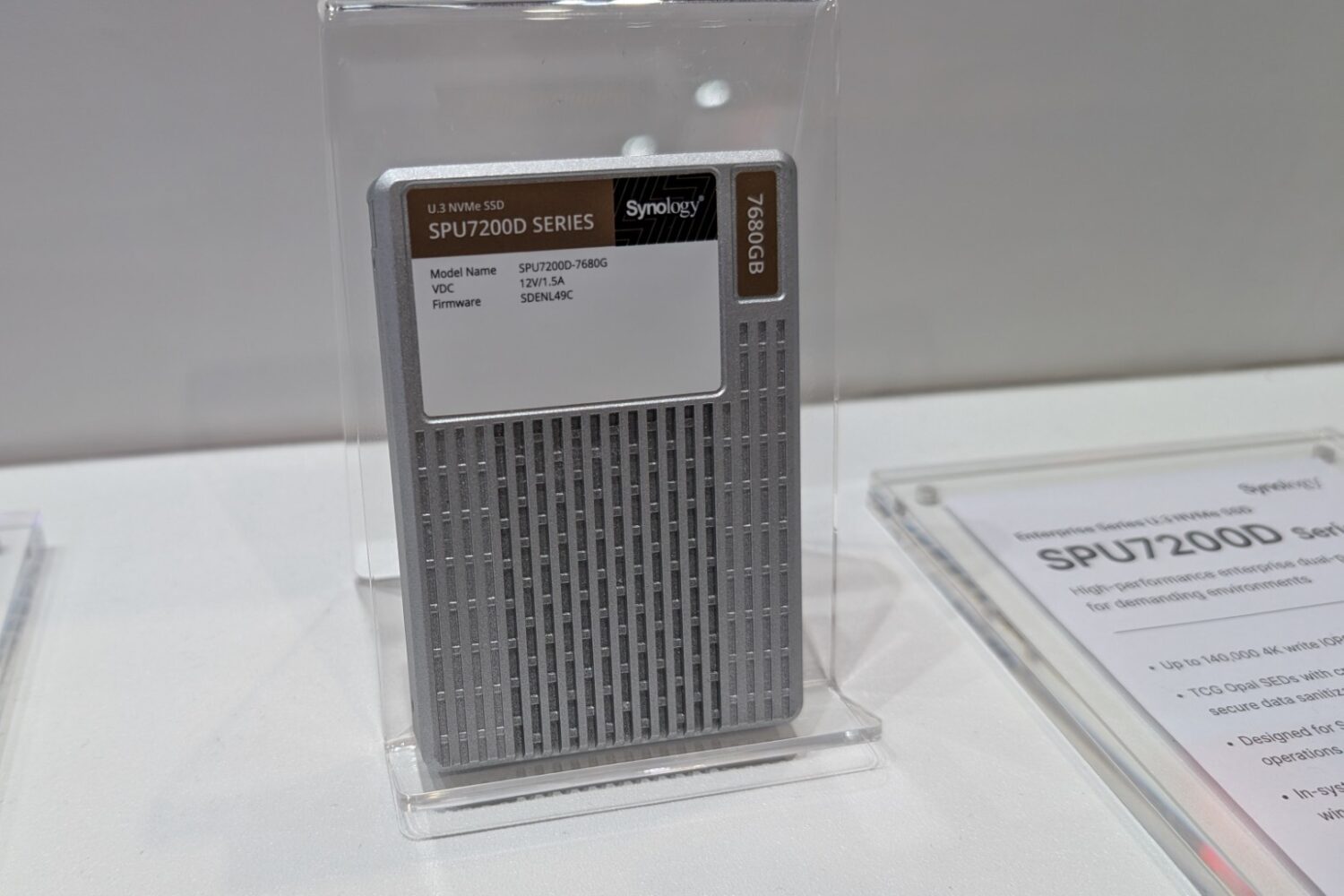
Each expansion unit adds space for 24 NVMe SSDs. A quick calculation tells us that a total of 216 SSDs can fit into this expanded system. According to Synology spokespeople, this should result in a total raw capacity of 1.65PB. This means that Synology equipped the PAS7700 with 8TB SSDs. These appear to be the only SSDs that Synology will equip the PAS7700 with at this time. So, no SSDs from other brands here either, although Synology will undoubtedly have them manufactured by one of the OEMs.
There are already SSDs with significantly higher capacities than 8 TB on the market. In other words, there is still room for growth in the maximum capacity of the system in the future. According to a spokesperson, the reason Synology started with the 8 TB SSD is that the PAS7700 is primarily aimed at users who want flash that is not only fast but also as reliable as possible and lasts as long as possible. The PAS7700 therefore uses TLC NAND flash. SSDs with higher capacities use the less reliable QLC NAND flash. This is not the right choice for the mission-critical workloads for which Synology developed the PAS7700.
The spokesperson we spoke to did indicate that Synology is looking into adding models with QLC flash. However, Synology cannot switch gears as quickly as some of the larger players in this market, so it had to make choices and focus entirely on the PAS7700 as it is now. In our opinion, that was a wise decision.
No DSM but PAM for Synology PAS7700
Looking at how the PAS7700 is managed, it becomes clear once again that this is a fundamentally different beast. Users don’t manage the device via DSM. Synology has built a different management environment for it. The name for it is PAM, or Parallel Active Manager.
One glance at PAM is enough to see that Synology wants to keep it recognizable. The design is exactly the same as that of DSM. This is smart, especially if Synology wants to sell the PAS7700 and later PAS models to existing customers. It immediately reduces the learning curve of a new system if you already know how to navigate it.
However, we estimate that new customers will also quickly feel comfortable with Synology’s management environment. Ease of use and clarity have always been important advantages of Synology’s management environments. Enterprise players such as NetApp and Pure Storage have also made great strides in simplifying management in recent years, but they have not gone as far as Synology with PAM. This may (and will) of course also be due to the number of options that these established players in the enterprise market offer more than Synology, but it is certainly also the result of a different conceptual starting point in the development of the environments.
Unlike the hardware, where the PAS7700 has been completely rebuilt, Synology has chosen to transfer a large part of the software from DSM to PAM. The spokesperson we spoke to did indicate that this is not just DSM with different functionality; a lot of hard work has also gone into improving performance. For example, Synology has made considerable improvements to the file system. This was necessary because the performance of the PAS7700 is so much higher that bottlenecks occur, for example when creating snapshots.
There is more to come than Synology PAS7700
With the announcement of the PAS7700, the company’s first true Tier 1 system, Synology is launching an offensive targeting the enterprise storage market. This attack will not stop with this product. A PAS3600 is also on the way, which is more focused on Tier 2 data. This is not an NVMe-based system, but a SATA-based system. It is a 2U model with 24 drives based on Intel Xeon processors. It will not feature 100GbE connections either. The expansion unit for the PAS3600 will go through life as the PAX212.
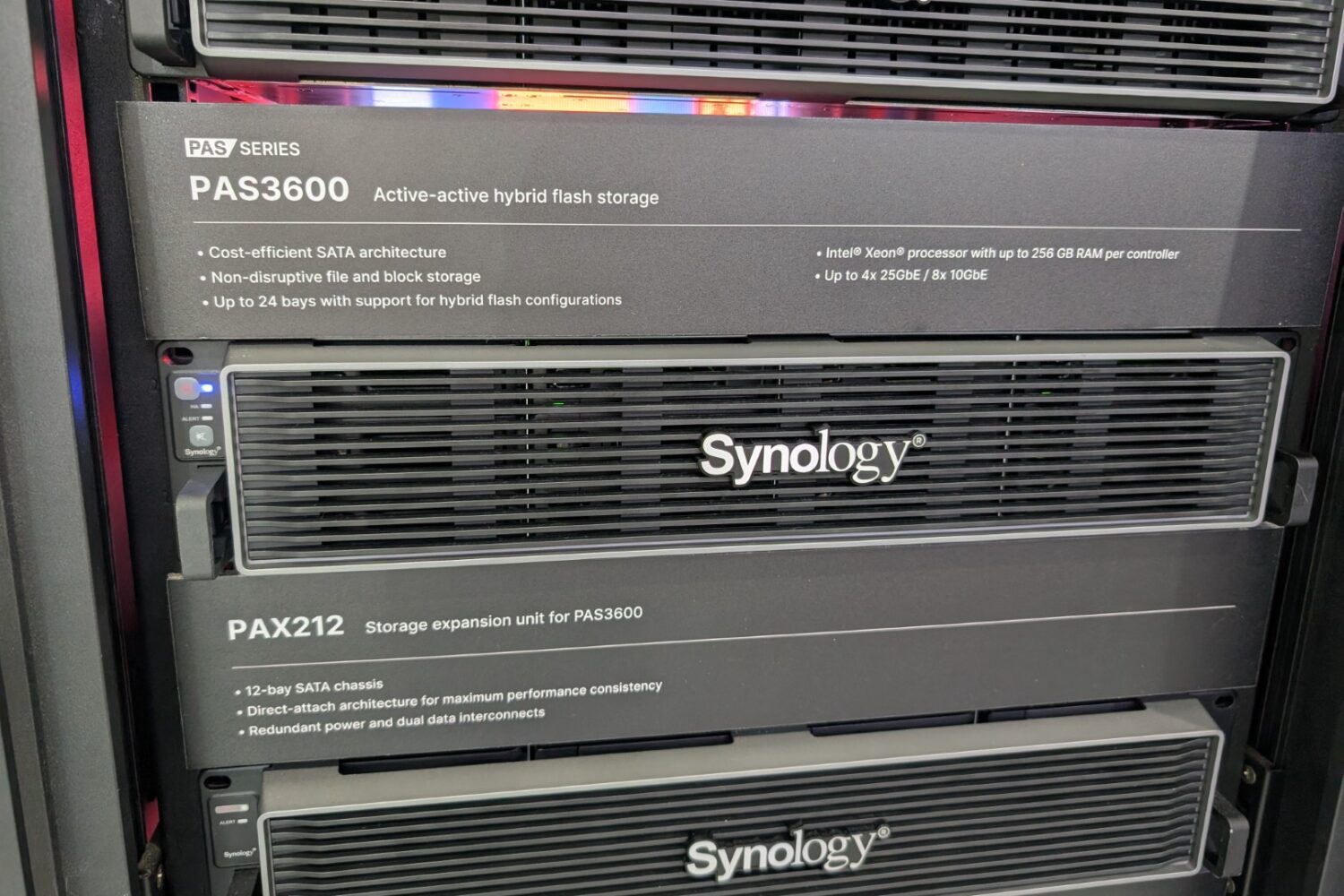
Furthermore, at the Synology booth at Computex, we see one last product coming soon at the very bottom of the rack. It is the GS3400. GS stands for GridStation. This is a scale-out storage product for file and object storage. In addition to SMB and NFS, it also supports the S3 protocol. Synology did not yet offer object storage in its line-up. However, with all the unstructured data that is used today for AI purposes, among other things, it is certainly a must-have if you want to play a serious role in the enterprise storage market. The Synology GS3400 can scale up to 48 nodes, with a minimum of 5 nodes. That translates into a maximum of 11.5 PB of raw storage capacity.
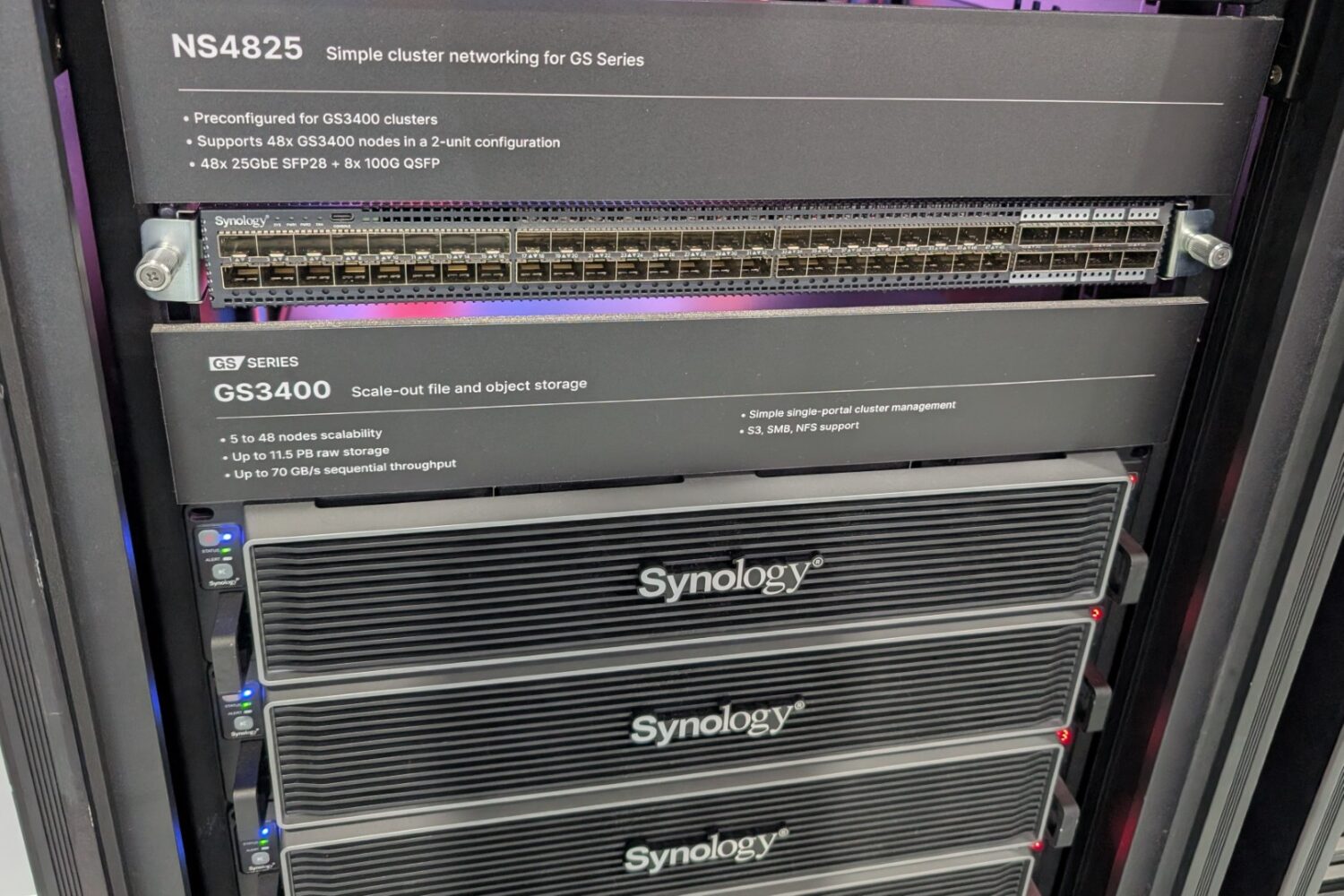
Finally, to ensure that the GS3400 connects properly to each other and to the network, Synology also offers the NS4825. This is a switch that Synology preconfigured to work with the GS3400, with 48 25GbE ports and 8 100G QSFP ports.
Synology has a pretty complete lineup
Synology has worked hard over the past few years to move step by step from the consumer and prosumer market to medium-sized businesses and now also to enterprise organizations. It has been a very steady and well-thought-out strategy. The company has been working on this since 2017. With this week’s announcements (none of which are available for purchase yet, with optimistic estimates of end of 2025 at the earliest), Synology has a fairly complete offering. It now also has several products for larger organizations.
In fact, the PAS7700 is not even the first product with which Synology intends to serve the enterprise market, Victor Wang points out in conversation with us. “The PAS7700 was not actually step 1 towards enterprise; that was actually the DP7400,” he notes in conversation with us. As a managing director of Synology, Wang is responsible for part of Europe, including France and the Benelux. The DP7400 is a backup appliance that also runs on AMD EPYC and has its own management version, just like the PAS7700. So they are more or less products from the same family. They do have completely different uses, but they are significantly more powerful and different from the rest of the range.
Opportunities for Synology PAS7700 with existing customers
Developing and building enterprise storage products is part of the challenge Synology took on in 2017. It seems to have succeeded in this. But the company still has a long way to go. It also has to be able to actually sell the products to customers. Synology likes to boast about the high percentage of large customers who already use its products. See the slide from the presentation earlier this week on the right.
These kinds of percentages look impressive, of course, and certainly indicate that Synology is successful in signing up larger companies. However, most of the products these companies have purchased are non-enterprise products. Synology will therefore have to convince these customers that they can replace their existing equipment from NetApp, HPE, Dell, or any other provider with products such as the PAS7700. We also note that these percentages are much higher for suppliers that focus exclusively on enterprise customers. This is because large companies typically use a huge number of products and services. Many suppliers can therefore claim percentages of over 80% and often even 90%.
Attracting new customers on price
In any case, Synology now has a complete story for its existing customers. Customers who are already deeply embedded in the ecosystem and don’t just have a DS or RS model somewhere to store images from a few cameras may find this particularly interesting. Especially if they are convinced of the user-friendliness of the management environment on other systems. This could be a decisive factor in their decision to switch.
However, we estimate that Synology will have to work very hard to even get a seat at the table with completely new customers. The storage market is not extremely dynamic, to put it mildly. With the exception of the emergence of Pure Storage over the past 15 years, there haven’t been many earth-shattering developments. Lately, we have mainly seen a shift from speeds and feeds to offering services that the supplier wants to guarantee. These are sometimes called SLAs, sometimes guarantees, among other names.
Of course, there have been innovations, and storage suppliers regularly refresh their lines or add new models. Synology will also have to respond to this. Will it go along with NetApp’s 18-month refresh cycle, for example? And is that even possible? When we ask Wang these questions, we don’t get a very clear answer right away. This is probably because the company is still in the process of scaling up production of this latest model. He does indicate that not all customers necessarily need the very latest, so frequent refreshes are not always necessary.
To remain attractive to new (and existing) customers, Synology has a lever it can pull, and that is the price. Wang indicates that it will certainly do so. “We are going to market the FAS7700 at a very competitive price, well below the products of other suppliers,” he says. The idea is that this should make Synology interesting enough to consider.
Will Synology succeed?
Finally, we asked ourselves whether we think Synology will succeed in breaking into the Tier 1 storage market. As already mentioned, this market is not particularly dynamic or changeable. Synology also has to compete with companies that are many times larger than itself. And the capabilities of PAM are not as extensive as those of the operating systems offered by the major players.
Furthermore, these larger players all have a huge network of integration partners. They market these players’ products and services and are rewarded for doing so. How will Synology ensure that its partners earn enough if it mainly markets its products at a much lower price? Wang realizes that this will be a major challenge and that Synology will also have to offer training and other services. Initially, this will probably be done directly through distributors.
Whether Synology can keep up with the rise of SLAs and warranties, which, based on what we are hearing from the market, are doing very well, is also a question mark for us. That is something completely different from building products. On the other hand, Synology does have a management environment that is ideally suited for easily offering, activating, and deactivating additional modules.
Don’t overestimate, but don’t underestimate either
All in all, Synology still has some work to do to really earn its place among the big boys. Whether it succeeds or not will depend on how it tackles this. A low price alone may be striking at first and attract attention. However, we also know that, especially when it comes to mission-critical workloads, price is often not the primary consideration for many organizations. Synology will therefore need to add another arrow to its quiver. In our opinion, this should be the management environment and software in general. This would allow it to clearly differentiate itself from its Tier 1 competitors.
Incidentally, Wang is quite modest when it comes to how much market share he wants. He would be happy if Synology could take one or two percent of NetApp’s share. That would be a huge leap forward for a company of Synology’s size. In our opinion, it is more realistic for Synology to focus on broadening and deepening the Tier 1 storage market for the time being. With the constant growth of data, more and more companies are doing important things with that data. They need a storage solution that fits their needs. With its lower price and well-developed software stack, Synology could well be the right choice for thoe companies.
In any case, we wouldn’t underestimate Synology too much. It may not be a huge company, but when you look at what they’ve achieved in recent years in terms of product development, it’s clear that they have a very clear vision. If you had told us in 2017 that Synology would announce the PAS7700, a Tier 1 storage system in 2025 that could compete with an (admittedly somewhat older) model from NetApp in terms of performance, we wouldn’t have believed you either.
Read also: Try the latest high-end Synology backup system, the DP7400, for free
